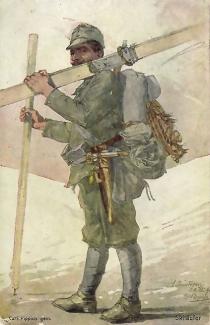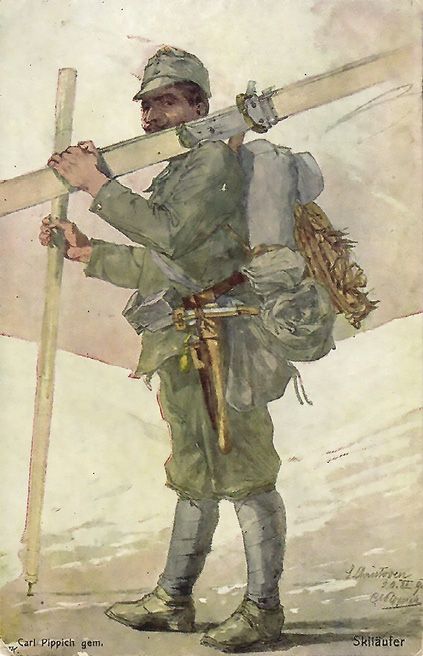Ski Art: Karl Pippich (1862-1932)

The three themes of Karl Pippich’s painting—mostly watercolors and gouaches—show his interest in the novelties of his city. For a while, around the turn of the century, he was known as “the portraitist of Vienna.” One easy-to-find example is the elaborate bridge structure spanning a city water-lock system. His other interests were landscapes and, especially, the military.

Pippich studied at the Akademie der Bildenden Künste, the Vienna Academy of Fine Arts, under Carl Rudolf Huber, who had returned from Egypt and in 1880 had become a professor at the academy. Pippich’s other professor was August Eisenmenger, who made a name for himself in painting scenes from Austrian history. Pippich took notice of this.
Here, then, was the young Pippich with all the colorful differences in the Austro-Hungarian army at hand. There was no better spectacle than when the troops paraded along the Ringstrasse, built between 1865 and the 1890s around the Altstadt of Vienna. This army, to keep up morale, preserved many regional colors, caps, pantaloons and demeanor. The Krakow regiment, for example, comprised 27 percent German, 33 percent Croat and 37 percent Polish. Officers were given three years to master the three languages. When World War I broke out, the call-up was announced in 11 languages. By that time, Pippich had painted many military scenes, of maneuvers as well as soldiers on break. One of the
best-known is of troops carousing, titled “Thirsty Throats” where,
still in battle drill, they are drinking hard, one out of his trumpet.
Pippich added to his reputation during the First World War (1914–18) as a member of the Austro-Hungarian Imperial War Press Office. He was sent to many battlefronts, including the mountain areas of the Carpathians and the Alps. By 1914, mountain soldiers were equipped for high Alpine fighting with camouflaged skis, snowshoes, and a spiked pole. Pippich’s painting was one of the official cards sold to benefit the Red Cross in its mission to save the wounded.